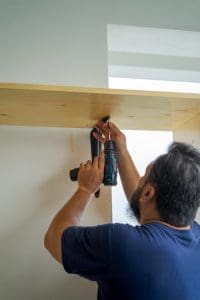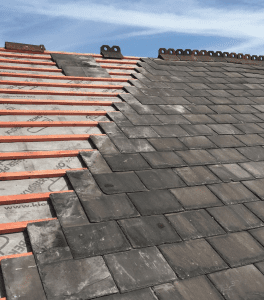At 3D Construction, we recognise that the unpredictable weather in the UK, particularly during the notorious April showers, poses unique challenges for roof maintenance. With regular rainfall being a defining characteristic of much of the UK, it’s crucial for homeowners to ensure their roofs are properly waterproofed to handle the continual exposure to moisture. In this comprehensive guide, we’ll explore the specific rainfall patterns that are typical across the UK during April and provide expert advice on waterproofing techniques and materials designed to withstand the demands of the country’s diverse and often wet climate.
Understanding the UK’s Rainy April
April is known for its fluctuating weather conditions throughout the UK, with frequent downpours followed by sudden bursts of sunshine. This month typically sees an average of 50 to 70 mm of rainfall in various regions, with some areas experiencing higher volumes due to their proximity to bodies of water or their geographical positioning. The consistent precipitation in April can amplify any existing roofing vulnerabilities such as leaks, worn materials, or poor drainage systems. Therefore, it’s essential for homeowners to be proactive in addressing these potential issues to prevent water damage during the spring months.
One common problem with April showers is the unpredictability of rain patterns. This erratic weather, where a dry spell is followed by heavy rainfall, can weaken roofing materials and allow water infiltration. Given these conditions, UK homeowners must ensure their roofs are equipped to handle not only heavy downpours but also the accumulation of moisture that might linger on the roof between rains.
Specialised Waterproofing Techniques
When preparing your roof for April showers, implementing specialised waterproofing strategies is essential. These methods help reduce the risk of leaks and structural damage caused by excess moisture, keeping your home dry and secure throughout the year.
1. Regular Roof Inspections
Routine roof inspections are a critical first step in maintaining roof integrity. Homeowners should schedule inspections at least twice a year, ideally before and after the wetter months. Inspections allow roofing professionals to identify and fix small issues—such as loose tiles, minor cracks, or worn-out sealants—before they evolve into significant problems. By detecting issues early, especially before the April rains, homeowners can save on costly repairs in the long term.
2. Sealant Application for Enhanced Protection
An effective way to guard against water infiltration is by applying high-quality waterproof sealants. Focus on vulnerable areas like roof seams, joints, flashing around chimneys, and skylights, where leaks are most likely to develop. A professional roofing contractor can apply sealants to form an impermeable barrier that blocks moisture. Modern sealants are durable and resistant to the UK’s fluctuating temperatures, ensuring long-term protection.
3. Roof Ventilation for Moisture Control
Proper ventilation in the attic and roof space is vital for controlling moisture and reducing condensation buildup. Without adequate airflow, condensation can accumulate, leading to mold, mildew, and rot, which weakens the structural integrity of your roof over time. By installing vents or upgrading your existing ventilation system, you can ensure that air circulates properly, preventing moisture buildup during wet months.
4. Gutter Maintenance for Effective Drainage
Keeping your gutters and downpipes clean and in good working condition is essential for proper water drainage. Clogged or poorly maintained gutters can cause water to pool on your roof, increasing the risk of leaks and water damage to both the roof and the foundation of your home. Regularly clear out debris, such as leaves and twigs, especially before the rainy season begins. Professional roofers can also inspect for any signs of sagging or damage to the gutters to ensure they function efficiently.
5. Considering Roof Pitch and Slope
The design of your roof plays a significant role in how well it handles rainfall. A steeper roof pitch allows rainwater to drain off more efficiently, reducing the risk of water accumulation that could lead to leaks. If you’re planning a roof renovation or a new roof installation, consulting with roofing experts about the ideal pitch for your location can make a substantial difference in waterproofing effectiveness.
Recommended Waterproofing Materials
Choosing the right materials for your roof can make all the difference in its ability to withstand heavy rainfall and long-term moisture exposure. Here are some of the best waterproofing materials suited for UK weather conditions:
1. Durable Roofing Membranes
Roofing membranes offer a reliable solution for waterproofing, particularly in regions with frequent rainfall. Synthetic membranes such as EPDM (ethylene propylene diene monomer) and TPO (thermoplastic polyolefin) are popular choices in the UK due to their flexibility, durability, and resistance to water infiltration. These materials are often installed as a base layer beneath the roof’s tiles or shingles and provide an additional layer of protection against the elements.
2. Weather-Resistant Roofing Tiles
Selecting tiles made from materials that offer high resistance to moisture is crucial. Clay, concrete, and slate tiles are excellent choices for UK roofs because of their ability to withstand heavy rains and varying weather conditions. These materials are naturally water-resistant and provide superior protection from rain, ensuring that your roof stays intact even during prolonged wet periods.
3. Liquid Rubber Coatings for Extra Defense
For homeowners looking to reinforce their roof’s waterproofing, liquid rubber coatings are a highly effective option. Applied as a liquid, this coating forms a seamless and flexible membrane that adheres tightly to the surface of your roof, filling any cracks or gaps and creating a watertight seal. Liquid rubber coatings are particularly beneficial for flat roofs, which are more susceptible to pooling and leaks, and can also be used as a preventative measure for sloped roofs.
4. Felt Roofing for Added Protection
Felt roofing is another popular material used for waterproofing flat roofs or as an underlayment for sloped roofs. Modern roofing felt is designed to be water-resistant and offers a cost-effective solution for enhancing your roof’s protection against the rainy UK climate. Paired with a top layer of tiles or shingles, felt roofing provides an additional barrier against moisture.
Roof Maintenance Tips for April Showers
In addition to implementing waterproofing techniques and materials, homeowners should follow these maintenance tips to ensure their roof remains in top condition:
- Remove Debris Regularly: Accumulated debris like leaves and branches can trap moisture on the roof, leading to moss growth and roof damage. Clear your roof of debris, especially after heavy storms.
- Check for Signs of Wear: Pay attention to any discolored patches on the roof, peeling paint, or mold in the attic, as these can be indicators of water infiltration.
- Reinforce Vulnerable Areas: Pay special attention to areas around chimneys, vents, and skylights, as they are more susceptible to leaks. Use high-quality flashing to ensure a tight seal around these structures.
Conclusion
April showers are a staple of the UK’s spring season, bringing with them unique challenges for roof maintenance. To protect your home from water damage, it’s essential to invest in robust waterproofing techniques and high-quality materials that can withstand the country’s relentless rain. By conducting regular inspections, applying effective waterproofing methods, and choosing the right roofing materials, homeowners can ensure their roofs remain strong, dry, and secure year-round.
At 3D Construction, we specialise in providing tailored waterproofing solutions for all types of UK roofs, offering expert guidance and services to ensure your home is protected from even the harshest weather. Contact us today for professional roofing advice and a competitive quote on how to waterproof your roof against the April rains and beyond.




